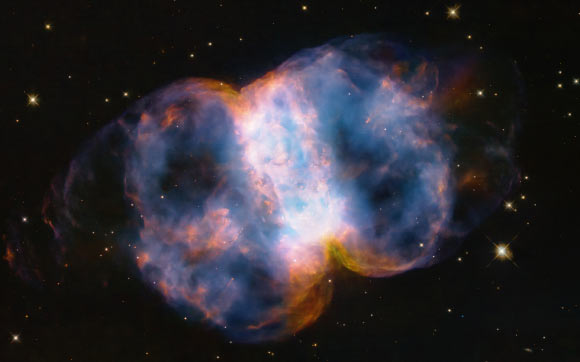Messier 76, also known as M76, NGC 650/651 or the Little Dumbbell Nebula, is a planetary nebula located approximately 3,400 light-years away in the northern constellation of Perseus.

This Hubble image shows Messier 76, a planetary nebula some 3,400 light-years away in the constellation of Perseus. Image credit: NASA / ESA / STScI.
Since its launch in 1990, the NASA/ESA Hubble Space Telescope has made 1.6 million observations of over 53,000 astronomical objects.
To date, the Mikulski Archive for Space Telescopes at the Space Telescope Science Institute holds 184 terabytes of processed data.
Since 1990, 44,000 science papers have been published from Hubble observations.
Hubble is the most scientifically productive space astrophysics mission in NASA history.
The demand for using Hubble is so high it is currently oversubscribed by a factor of six-to-one.
Most of Hubble’s discoveries were not anticipated before launch, such as supermassive black holes, the atmospheres of exoplanets, gravitational lensing by dark matter, the presence of dark energy, and the abundance of planet formation among stars.
In celebration of the 34th anniversary of Hubble’s launch, astronomers took a snapshot of the planetary nebula Messier 76.
“Messier 76 is located approximately 3,400 light-years away in the northern constellation of Perseus,” the Hubble astronomers said.
“It is classified as a planetary nebula, an expanding shell of glowing gases that were ejected from a dying red giant star. The star eventually collapses to an ultra-dense and hot white dwarf.”
“Planetary nebulae are unrelated to planets, but have that name because astronomers in the 1700s using low-power telescopes thought this type of object resembled a planet.”
“Messier 76 is composed of a ring, seen edge-on as the central bar structure, and two lobes on either opening of the ring. Before the star burned out, it ejected the ring of gas and dust.”
“The ring was probably sculpted by the effects of the star that once had a binary companion star.”
“This sloughed off material created a thick disk of dust and gas along the plane of the companion’s orbit.”
“The hypothetical companion star isn’t seen in the Hubble image, and so it could have been later swallowed by the central star.”
“The primary star is collapsing to form a white dwarf,” the researchers said.
“It is one of the hottest stellar remnants known at a scorching 139,000 degrees Celsius (250,000 degrees Fahrenheit), 24 times our Sun’s surface temperature.”
“The sizzling white dwarf can be seen as a pinpoint in the center of the nebula. A star visible in projection beneath it is not part of the nebula.”
“Pinched off by the disk, two lobes of hot gas are escaping from the top and bottom of the ‘belt,’ along the star’s rotation axis that is perpendicular to the disk.”
“They are being propelled by the hurricane-like outflow of material from the dying star, tearing across space at two million miles per hour.”
“That’s fast enough to travel from Earth to the Moon in a little over seven minutes!”
“This torrential stellar wind is plowing into cooler, slower-moving gas that was ejected at an earlier stage in the star’s life, when it was a red giant.”
“Ferocious ultraviolet radiation from the super-hot star is causing the gases to glow. The red color is from nitrogen, and blue is from oxygen.”
“Given our Solar System is 4.6 billion years old, the entire nebula is a flash in the pan by cosmological timekeeping. It will vanish in about 15,000 years.”

